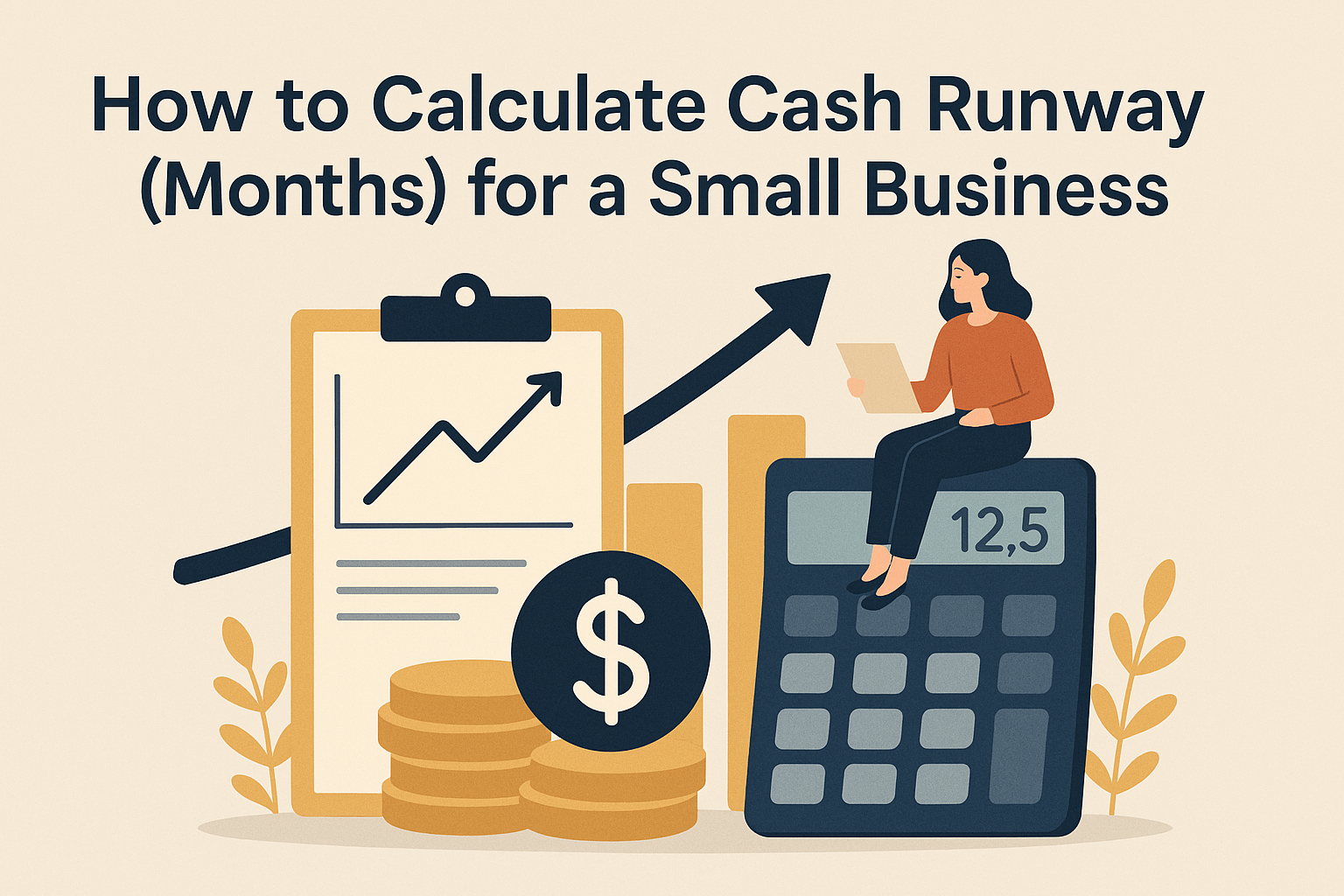How to Calculate Cash Runway (Months) for a Small Business
Owners ask one thing: “Am I OK on cash?” This guide gives you the fast answer—months of runway—plus a weekly routine and quick fixes if the number’s low.
What Is Cash Runway?
Cash runway is how many months your business can operate at today’s spending rate before cash runs out. It’s a timing metric—not a profit metric—so it answers “how long” more than “how healthy.”
Why it matters
- ✅ Turns bank balance into a forward-looking plan (no more guesswork)
- ✅ Gives hiring, inventory, and marketing decisions a safe window
- ✅ Creates a calm, repeatable rhythm for owners and operators
Cash Runway Formula (Simple Example)
Runway (months) = Current Cash ÷ Average Monthly Operating Expenses
Example: $60,000 cash ÷ $12,000 monthly spend = 5 months of runway.
| Bank balance glance | Runway formula | |
|---|---|---|
| Time horizon | Today | Next few months |
| Usefulness | Static snapshot | Decision-ready window |
| Actionability | Unclear | Clear actions (collect, delay, invest) |
Instant Check: Get Your Months of Runway
Use this two-input helper—enter your current cash and average monthly operating expenses:
Open the Cash Flow Health Checker ↗
Tip: If your spend swings, average the last 3 months, excluding one-off items like asset purchases.
“Am I OK?”—Interpret Your Result
- Excellent (≥6 months): Healthy cushion. Keep collections tight; consider planned hires or marketing. Build scenario cases before committing.
- Safe (3–5.9 months): On track. Maintain discipline, line up contingencies, and keep a rolling pipeline view.
- Warning (1–2.9 months): Act this week—prioritize collections, pause non-critical spend, and nudge pricing on new work.
- Critical (<1 month): Move now—daily visibility, collections surge, temporary spend cuts, and payment sequencing.
QuickBooks Sanity Check (Trust Your Number)
- Bank feeds: Connected and last month reconciled (no stale transactions).
- AR/AP: Who owes you and what you owe—due dates are realistic, duplicates resolved.
- Commitments: Payroll, taxes, rent, loans, subscriptions listed for the next 4–8 weeks.
- Owner draws & credit cards: Included in outflows so runway isn’t overstated.
Weekly 30-Minute Cash Routine
- Confirm cash: Use reconciled operating account balance (and any secondary operating accounts).
- List must-pay outflows: Next 2–4 weeks—payroll, rent, taxes, loan payments, due bills.
- List expected inflows: Invoices due, retainers, deposits likely to land; include confidence levels.
- Recalculate runway (months): Cash ÷ average monthly operating expenses.
- Explain the change: In 2–3 bullets, note why cash moved since last week.
- Choose three actions: Collections push, pause/delay spend, pricing nudge, timing shift.
- Book next check: Same day/time weekly; repeat the exact steps.
Outcome: Calm, repeatable decisions—no last-minute scrambles.
Fast Fixes for Common Problems
AR is overdue — how do I collect faster?
- Sort invoices oldest-first; send a three-email sequence: friendly reminder → due-today nudge → escalation with payment link.
- Turn on auto-reminders; offer ACH/credit card; add late-fee policy going forward.
- Call top 5 balances today—don’t wait for the email to work.
Expenses keep creeping — what do I cut?
- Review spend by vendor. Cancel, pause, or downgrade anything unused last month.
- Delay nice-to-have projects; push non-critical renewals past the tight window.
- Move annual prepaids to monthly temporarily for flexibility.
Profit is up but cash is tight — why?
- Usually timing: slow AR, inventory buys, or debt service. The weekly routine surfaces this quickly.
- Large deposits or prepaids distort a single month—use 3-month averages for runway.
Too many KPIs — what should I track?
- For the next 30 days: collections rate, pricing on new quotes, and controllable spend.
Owner-Ready Templates (Use Today)
- Runway snapshot grid: Cash today • Inflows this month • Outflows this month • Runway (months)
- 3-email collections sequence: Friendly reminder → Due-today nudge → Escalation with payment link
- Pricing nudge checklist: Adjust the next 10 quotes when demand or costs shift
- Payment sequencing list: Who gets paid when cash is tight (payroll, taxes, critical vendors first)
Where FinalyzeIQ Helps
FinalyzeIQ turns raw numbers into plain-English insights, benchmarks, and an 8-week cash outlook—so your 30-minute check becomes a quick weekly rhythm that leads to decisions, not just reports.
Under 3 Months of Runway—or Want a Pro to Double-Check QuickBooks?
Book a free, 20-minute “Cash Clarity” call with Bookkeeping Express. We’ll verify your inputs, confirm your runway, and give you three practical next steps you can implement immediately.
- QuickBooks sanity check (bank feeds, AR/AP, reconciliations)
- Plain-English snapshot of where you stand and why it moved
- Three tailored, no-fluff action items
Prefer to read first? Ask us for the 1-page runway checklist and a sample weekly cash template.
FAQ
Should I include credit lines in cash?
Keep runway conservative: calculate using actual cash. Track credit availability separately as a safety valve.
What expenses count in the denominator?
Use operating expenses you must pay to keep the lights on (payroll, rent, vendors, software, taxes, debt service). Exclude one-off capital purchases.
How often should I update runway?
Weekly, after reconciling bank and reviewing AR/AP. Monthly is too slow when runway is under six months.
Can I be profitable and still have short runway?
Yes—timing gaps between sales and collections can choke cash. That’s why the weekly routine matters.
What’s a good goal?
Most small businesses are comfortable at 3–6 months. Capital-intensive or seasonal businesses may target more.

